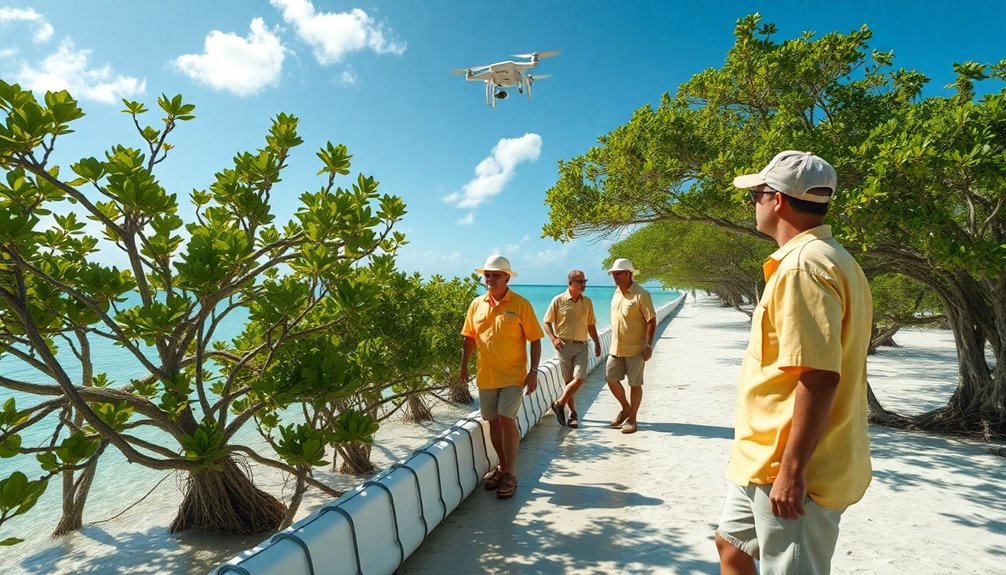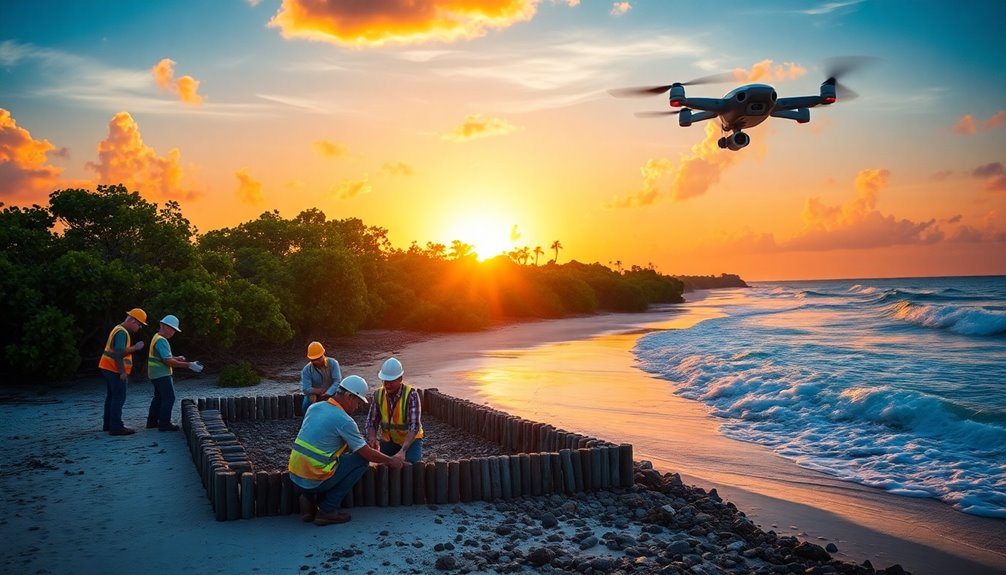Coastal protectors are stepping up to ensure the Florida Keys' shores stay safe amid rising sea levels and climate change. They're blending natural features like mangroves with engineered solutions for effective shoreline protection. This hybrid approach helps stabilize coastlines, supports biodiversity, and enhances ecosystem resilience. However, only a small portion of the shoreline can support such efforts, highlighting the need for collaboration among agencies and stakeholders. There's much more to this innovative strategy, and you'll want to know the details.
Key Takeaways
- Coastal protectors are implementing hybrid approaches combining natural features and engineered solutions for enhanced shoreline resilience in the Florida Keys.
- Restoration of mangroves and coastal strands is prioritized to stabilize shorelines and support local biodiversity against climate change impacts.
- Technological tools like GIS and machine-learning models guide effective shoreline management and restoration efforts in the Florida Keys.
- Collaboration among public agencies and private stakeholders is essential for successful restoration projects, given the limited suitable shoreline areas.
- Innovative strategies, including soft armoring techniques, are being developed to provide tailored protection for vulnerable coastal regions.

As climate change continues to threaten the Florida Keys, coastal protectors are stepping up to safeguard this unique ecosystem. You can see the urgency in their efforts, especially with a projected sea level rise of 0.25 to 0.30 meters by 2050. This increase heightens flooding risks in low-lying areas and makes the region more vulnerable to storms. Given the severe hurricanes the Keys have faced since 2015, including Irma, Ian, Helene, and Milton, it's clear that action is needed now more than ever.
One key strategy involves restoring mangroves and coastal strands, which are vital for stabilizing shorelines and enhancing local ecosystems. These natural barriers not only protect against flooding but also support biodiversity, making them essential to the health of marine and estuarine systems. Additionally, the region's geographical sensitivity increases its climate-related hazards vulnerability.
Restoring mangroves and coastal strands is crucial for shoreline stabilization and enhancing biodiversity in the Florida Keys.
Coastal protectors are combining these natural features with engineered solutions, creating hybrid approaches that offer more robust shoreline protection. You might be surprised to learn that living shorelines require careful planning to maximize their effectiveness, and soft armoring techniques, using materials like plants and rocks, provide tailored protection.
Technological advancements also play a crucial role in shoreline management. With the integration of GIS technology, coastal managers can analyze human-made impacts alongside environmental data. This allows them to pinpoint areas that need protection, guided by tools like the Shoreline Relative Exposure Index.
Machine-learning models add another layer of insight, helping to determine the best stabilization options based on expert survey data.
However, challenges remain. Only about 8% of the Florida Keys shoreline is suitable for nature-based or hybrid solutions, while 25.1% is deemed unsuitable. Effective restoration requires cooperation between public agencies and private stakeholders, as regulatory compliance is vital for success.
Frequently Asked Questions
What Are the Main Threats to Florida Keys' Coastal Ecosystems?
The main threats to the Florida Keys' coastal ecosystems include human activities like land development and tourism, which lead to habitat destruction.
Water pollution from runoff degrades water quality, while invasive species disrupt native habitats.
Overfishing alters marine dynamics, and climate change exacerbates these issues with rising sea levels, warming waters, and intensified storms.
You need to be aware of these threats to understand the importance of protecting these fragile ecosystems.
How Can Residents Get Involved in Coastal Protection Efforts?
You can make a difference in coastal protection efforts, whether you're cleaning up beaches or attending workshops.
While some might see the coast as just a place for fun, it needs your help. Participate in public comment periods to influence local policies, join local chapters of organizations, or volunteer for habitat restoration.
What Technologies Are Being Used for Coastal Protection Innovations?
You'll find that various technologies are revolutionizing coastal protection. Advanced GIS helps analyze shorelines, while machine learning algorithms identify the best stabilization options.
Nature-based solutions, like restoring mangroves, enhance ecosystems and stabilize shorelines. Hybrid approaches combine natural materials with engineered solutions for added resilience.
AI-driven systems monitor conditions in real-time, and remote sensing evaluates the effectiveness of defenses over time, ensuring a comprehensive strategy for protecting coastal areas.
Are There Volunteer Opportunities for Coastal Protection Projects?
Did you know that about 8% of the Florida Keys' coastline is suitable for nature-based or hybrid shoreline solutions?
If you're looking to get involved, there are plenty of volunteer opportunities for coastal protection projects. You can join programs like the Conch Republic Marine Army for mangrove restoration or participate in local cleanups with Keep Key West Beautiful.
Your efforts can make a real difference in preserving this beautiful ecosystem.
How Does Climate Change Impact the Florida Keys' Shores?
Climate change significantly impacts the Florida Keys' shores. Rising sea temperatures lead to coral bleaching, while ocean acidification affects marine life.
You'll notice increased flooding and erosion as sea levels rise, threatening habitats and infrastructure.
Storm intensity also escalates, causing further damage to coastal ecosystems.
As these changes unfold, you might witness a decline in biodiversity and economic pressures on local communities, making resilience efforts more crucial than ever.
Conclusion
In the battle against erosion, you're witnessing innovation like never before in the Florida Keys. Coastal protectors are tirelessly working to safeguard these shores, ensuring they'll stand strong against nature's fury. With their groundbreaking techniques and unwavering dedication, they're not just preserving the landscape; they're creating a fortress of resilience that could rival the Great Wall of China! By supporting these efforts, you're helping to secure a vibrant future for this stunning paradise.









